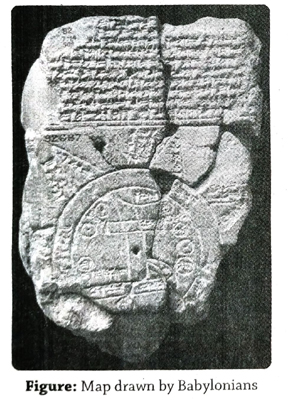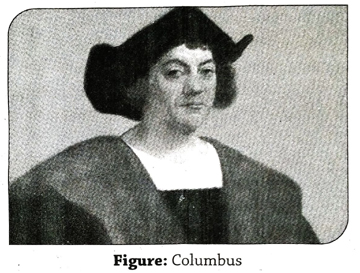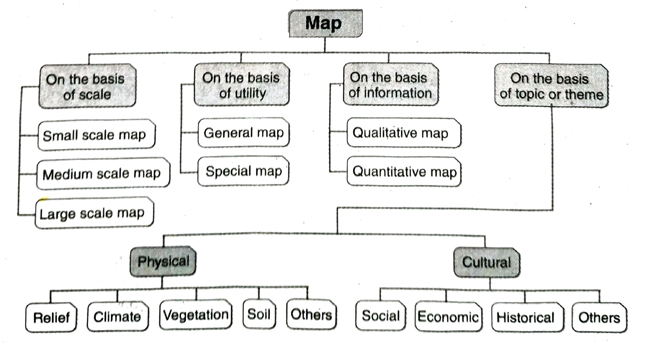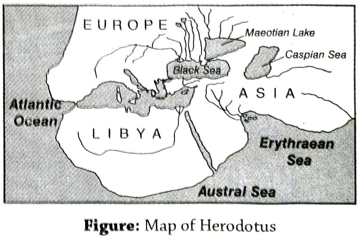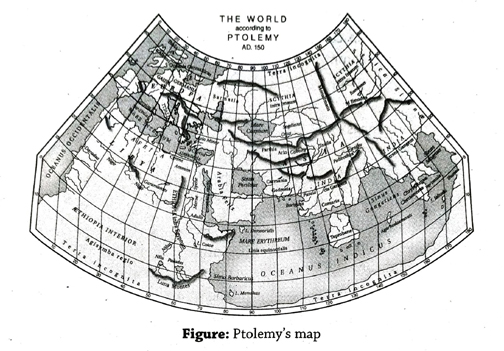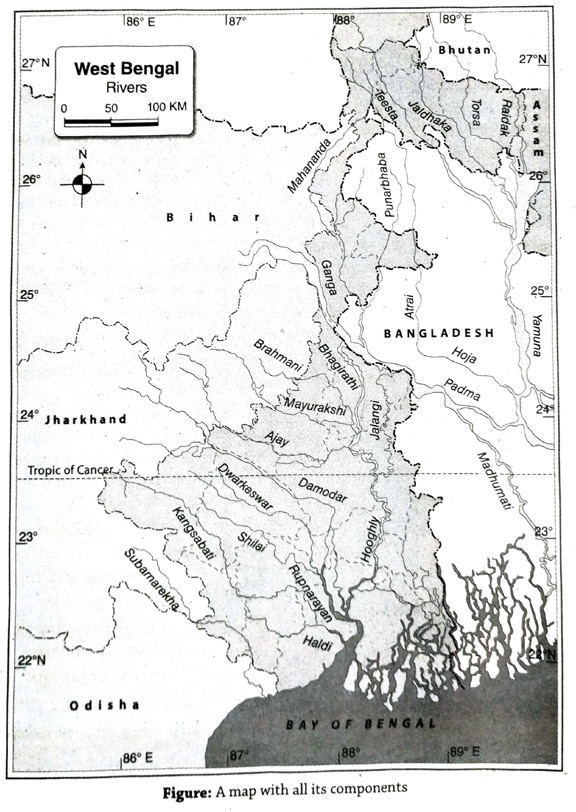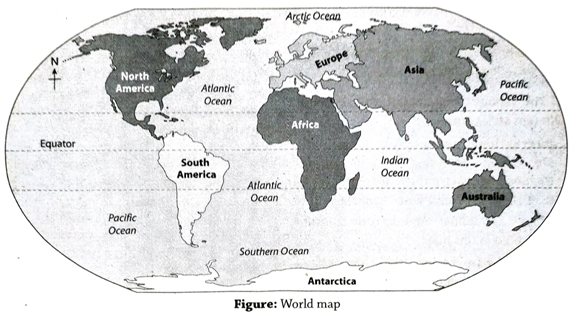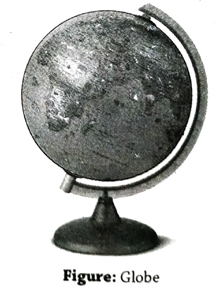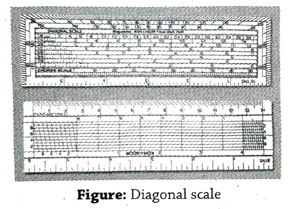WBBSE 9th Class Social Science Solutions Geography & Environment Chapter 9 Maps and Scale
West Bengal Board 9th Class Social Science Solutions Geography & Environment Chapter 9 Maps and Scale
WBBSE 9th Class Geography & Environment Solutions
Salient points – At a Glance
- Scale is the ratio between the length of two points on the map and the distance between that two points on the ground. A scale of a map can be represented in various forms.
- A map is a graphic representation of the features of the Earth’s surface as drawn on a flat paper, according to a specific scale and on a specific map projection, using internationally accepted signs and symbols.
- Any map cannot be 100% correct due to the representation of three dimensional Earth on a two dimensional plane. Still, efforts are made to draw a map closest to its actuality on a two dimensional plane.
- A small scale map depicts a large area on paper. Wall map, atlas, etc. are examples of small scale maps.
- On a large scale map a small area is depicted on paper in larger form. Cadastral map or mauza map is an example of a large scale map.
- Mauza is the lowest administrative unit of India. Its another name is census village. The scale of a cadastral map or mauza map is usually 16 inches to 1 mile.
- Thematic Map depicts a specific theme or subject on a map. But sometimes a ore than one thematic map depicts more subject also. If it does so, then certainly the other subjects complement the main one.
- The conventional signs, symbols and use of colours in a map are explained. through an index. That is why, index is called the key of a map. An index may also be labelled as a legend.
- There are three types of scales that are used in a map. They are—statement scale, fractional scale and graphical scale.
- Statement scale is a type of map scale expression in which, the relation between the distance of two points on a map and the actual ground distance between those two points is expressed in the form of a written statement.
- Representative fraction is a type of map scale expression in which, the relation between the distance of two points on a map and the actual ground distance of those two points is expressed in ratio.
- A type of map scale expression in which, the relation between the distance of two points on a map and the actual ground distance of those two points is expressed the help of graphical representation, is known as graphical with scale.
TOPIC – A
Map
Long Answer Type Questions
1. Give a brief account of the history of development of maps.
Ans. A brief account of the history of development of maps: When the world or a part of it is represented on a flat piece of paper drawn to a specific scale and map projection, using universally accepted conventional signs and some basic principles, it is called a map.
The history of map-making is quite oldabout 4000 years. It can be discussed as follows
According to anthropologists, the maps drawn by the Eskimos, Red Indians, and Marshall Island dwellers are quite old. Charts were made on palm leaves that were attached to narrow frames and shells of snails or fishbones were used. Straight lines were drawn to denote the sea and curved lines to denote the waves approaching the island.
The people of Babylon were the first to divide a circle into 360 parts. The four cardinal points-north, south, east and west, were also first used by them while drawing maps.
The Greeks were experts in Mathematics and Astrology. They were responsible for drawing the lines of Equator, Tropics of Cancer and Capricorn, North and South Poles on a spherical world. Eratosthenes was the most well-known person who could draw maps accurately. Herodotus (485 BC – 425 BC) believed that the Earth was round, comprising of Asia, Europe and Libya. Ptolemy drew a map of the world as well as 26 regional maps published in his book ‘Geographia’.
Many sailors while exploring different parts of the world, drew maps of newly discovered lands. Columbus was most famous among them. Remassus II, the Egyptian Pharaoh, drew a map of his empire for the convenience of tax and revenue collection.
The science of map-making (cartography) was thus initiated and it gained much importance at that time.
2. What is a map? Classify the different types of maps. ?
Ans. Map: A map is a graphic representation of the features of the Earth’s surface as drawn on a flat paper, according to a specific scale and on a specific map projection, using internationally accepted signs and symbols.
Different types of maps: There are different types of maps on the basis of different aspects. They are-
1. Classification of maps based on scale:
- Small scale maps: When a map is drawn in a small dimension on a piece of paper, representing a bigger land surface, a small scale is used. These are known as small scale maps.
Advantages: (a) As the scale is small, a bigger area can be represented on a smaller dimension on space or a piece of paper. (b) The whole world or a part of it can be represented on paper.
Disadvantages: (a) Various symbols are used to show different components on the map which might not be easily understandable by a layman. (b) Due to smaller space or dimension, details of the area cannot be shown.
Example: Wall map, international map, navigation map, etc.
- Medium scale maps: When any large area is divided into smaller areas on a medium scale to represent on paper (i.e., map), it is called a medium scale map. Example-topographical maps.
- Large scale maps: When a small area is shown on a larger dimension, it is known as a large scale map. Example-cadastral maps.
2. Classification of maps based on utility:
- General map: When a map can be easily used or understood by the common people, it is known as a general map. Exampledistrict map of West Bengal.
- Special map: When a map is drawn for any specific purpose, it is known as a special map. Example-physical map of India.
3. Classification of maps based on information or data:
- Qualitative map: This map shows the qualitative aspect of any geographical feature.
- Quantitative map: This map shows the quantity wise variation of geographical features, such as altitude, area, etc. Example-population density map of India, dots and sphere maps, etc.
4. Classification of maps based on topic or theme:
- Physical map: This type of map shows the physical features of any area. Examplerelief map, climate map, etc.
- Cultural map: When any cultural aspect is shown on a map, it is called a cultural map. Usually, the socio-economic or political aspects are depicted in such maps. Example-social map, economic map, etc.
3. Write a note on the contributions of the important cartographers.
Ans. Note on the contributions of the Important cartographers: The Greek philosopher, Anaximander (610 B-546 BC) was the first to draw a map of a human settlement according to scale. In his map, Greece was shown in the centre of Europe and the land portion of the world was surrounded by seas on all sides.
The Greek philosopher, Eratosthenes (276 BC-194 BC) is known as the ‘Father of Geography. He was the pioneer in using lines of latitudes and longitudes on accurately drawn maps.
Hecataeus (550 BC-476 BC) slightly modified the map drawn by Anaximander and drew it accurately with more descriptive details. This was a map showing Eurasia.
Herodotus (484 B-425 BC) is known as the ‘Father of History’. He believed that the area of land between the coastal areas of India and Spain was surrounded by seas and oceans. He divided the Earth into Asia, Europe and Libya.
Several other scholars also gave importance to drawing maps. Among them, there can be a mention done of the Roman philosopher Strabo (64 BC-24 AD) and Claudius Ptolemy (90 AD168 AD). Ptolemy drew about 26 regional maps of different parts of the world.
In the later period, Chinese geographers and scientists drew maps on the basis of grids. Zhang Heng (78 AD-139 AD), Fi Sui (224 AD-271 AD), Chu Su Pin (1273 AD-1337 AD), etc., were wellknown for drawing maps. Fi Sui is known as the ‘Father of Map Science’. This person drew the political map of China on a large scale in 276 AD.
In the middle ages, an Arabian geographer Al Idrisi (1099 AD-1161 AD) tried to draw maps as well. In the later period, Columbus, Magellan, James Cook and several other explorers made huge improvements in the methods of mapmaking.
In the modern days, Cartography is hugely digitised with the application of Geographic Information System (GIS) techniques. But, these ancient cartographers are the ones who had laid down the foundation of map-making.
4. What is a thematic map? Classify thematic maps and describe each type.
Ans. Thematic map: A thematic map is based on the physical and cultural aspects of an area.
Classification and description of thematic maps: Thematic maps can be of two typesphysical map and cultural map.

- Physical map: This map shows the physical features like relief, climate, and so on, of any place. Physical maps can be of various types-
- Relief map: This map helps to identify the altitude, slope, rock types, etc. E.g., the hilly, plateau and plain regions of India can easily be identified from the relief map of India.
- Climate map: This map is based on climatic features like air pressure, rainfall, wind, cloudiness, etc. E.g., from the rainfall map of India, we can have an idea of the areas receiving high and low rainfall.
- Vegetation map: The types of natural vegetation is shown on such a map. E.g., from the natural vegetation map of India, evergreen, deciduous, coniferous forests can be identified.
- Soil map: It is drawn on the basis of the characteristics of soil of a region. E.g., the soil map of India reveals that the Gangetic Plain has silt, the Rajasthan region has sand and the Deccan Plateau region has black cotton soil.
- Others: Space related topics such as location of stars and planets and also rock types, drainage basins and other such features on the Earth’s surface are shown on these maps.
- Cultural map: The cultural aspects like social, political, historical, economic, etc. of a particular region are shown on maps called cultural maps.
- Social map: The maps drawn on the basis of social aspects such as population distribution, tribal population density, linguistic data etc. are called social maps. E.g. a map drawn on the different languages spoken in India.
- Economic map: These maps show the distribution and characteristics of agricultural, mineral, forest, industrial products. E.g. the mineral map of India shows how the Chota Nagpur Plateau region is rich in minerals.
- History map: These maps show the historic places of the past, boundaries of the kingdoms and empires, etc. E.g. the expanse of the Mughal Empire shown on the history map of India.
5. Which components are used for drawing a map? Give examples.
Ans. Components used for drawing a map: When the world or a part of it is represented on paper as a map, the following components are of vital importance-
- Scale: Any part of the Earth’s surface can be shown on paper in a reduced or enlarged form with the help of specific scales.
- Map projection: The graticules (longitudes and latitudes) on which the map is drawn is known as map projection.
- Paper or flat surface: A paper or a flat surface on which the map is to be drawn is required.
- Choosing a subject or theme: Specific themes, subjects or topics have to be determined before drawing a map.
- Selecting alphabets: This has to be done for writing the heading, scale, north line, index or a key, etc.
- Drawing boundaries: Different symbols for boundaries showing country, states, districts, coastal areas, etc., have to be chosen and marked on the map.
- Index or Legend: An index is required as a key to the conventional signs and symbols used on a map.
For example, in the fig. 9.12 (given in next page). it can be observed that-
- The scale of the map is 1 cm = 50 km (approximately).
- On the basis of map projection the map has been drawn with a latitudinal extent of 22°N 27°N and longitudinal extent of 86°E-89°E.
- The map is drawn on a flat surface, i.e., on paper.
- The theme of the map is-‘Rivers of West Bengal’.
- ‘Rivers’ is written on top (north-west corner) of the map.
- Different symbols which are internationally approved are used to show the boundaries of a country, states, states, districts and coastal areas.
Short Explanatory Answer Type Questions
1. What is the importance of a map?
Ans. A map is a drawing that is done in accordance to a particular scale and a specific projection using lines of latitude and longitude and internationally accepted colours, symbols, etc., from which many geographical data can be obtained. The importance of a map is unparalleled. Few of them are as follows-
- Universality: A map is used not only by a geographer, but also by people from various other professions. Thus, it has a universal value.
- Main tool of geographers: A map is the main tool of a geographer. An idea about the geographical aspects of any region of the world can be made studying maps.
- Administrative work: A map is necessary for several administrative purposes. For example, a cadastral map is of utmost importance in the collection of land revenue and taxes.
- Defence purposes: Military personnel plan their routes in any region using the map of that part. Topographical maps play a major role in this respect.
Besides, maps are of great use to tourists visiting unknown areas.
2. What are the different types of quantitative maps?
Ans. There are various types of quantitative maps. They are as follows-
- Isoline maps: The maps where lines are drawn joining different places having same values (of air pressure, rainfall, etc.) are known as isoline maps. These maps can be of various types- (1) isobar maps, (2) isotherm maps, (3) isohyet maps, (4) isohaline maps, (5) isohel maps (6) contour line maps, etc.
- Symbolic maps or maps with conventional signs: Several internationally accepted signs and symbols are used to draw these maps. These can be of various types- (1) dot distribution maps, (2) circle maps, etc.
- Geometric maps: These maps include- (1) spherical maps, (2) choropleth maps, (3) flow maps, etc.
3. Name the topographical maps included in different series.
Ans. The various topographical maps included in different series are-
- International series map: These maps are drawn according to international treaties. The scale of the maps of this series is 1:100000. Any area spanning over 4° × 4° latitudinal and longitudinal extent is covered in this map.
- South Asian series: Iran, Afghanistan, Saudi Arabia, India, Pakistan, Sri Lanka, Bangladesh, China, Myanmar, Thailand, Vietnam, etc., are included in this series. The scale used in the series is 1: 200000. It spans over an area of 8° × 12° latitudinal and longitudinal extent.
- Series of India and her neighbouring countries: These maps are drawn to a scale of 1: 1000000. An area spanning over 4° × 4° latitudinal and longitudinal extent is covered in this map.
- Map of the Survey of India department: For the ease of conducting surveys, the Survey of India department has divided the Indian subcontinent from 64° East to 100° East and 4° North to 40° North into 4° × 4° grids.
4. What is a political map? Mention some of its characteristics.
Ans. A map that depicts districts, subdivisions, boundaries and important places of states and countries is known as a political map. The political map of every district depicts its subdivisions, CD Block, municipal towns, important offices, etc.
Some of the characteristics of political maps are- (1) Different administrative blocks are demarcated using lines and several symbols. (2) The bordering/neighbouring countries, states, districts are all shown in this map. (3) An idea about the political and administrative conditions of the area depicted can be made from these maps.
5. What do you mean by a globe? Discuss its importance.
Ans. A globe is a small model or representation of the Earth. It is of much importance to geographers as well as people in other professions.
The importance of globe are as follows- (1) An overall picture of the whole world can be obtained from a globe. (2) An idea about the concept of scales can be made by observing a globe. (3) An idea about the exact locations of oceans, seas and continents can be made from a globe. (4) The spinning of the globe gives an idea about the rotation of the Earth.
6. Topographical maps are of utmost importance to geographers.’ Explain.
Ans. A topographical map is of vital importance to geographers because-
- Determining the relationship between physical and cultural environment: The relationship between different physical and cultural aspects of the environment can be determined through these maps, and this knowledge is valuable for geographers.
- Nature of a region: Natural vegetation and relief (rivers, hills, plateaus, plains, etc.) of any area can be easily determined from these maps.
- Useful in developmental planning: The construction of roads, railways, etc., together with local and regional planning, is done based on topographical maps.
Short Answer Type Questions
1. What is map?
Ans. A map is a graphic representation of the features on the Earth’s surface. It is drawn on flat paper using a specific scale, and with internationally accepted signs and symbols.
2. How were maps made in the ancient times?
Ans. The maps drawn by the Eskimos, Red Indians and the inhabitants of Marshall Island are considered to be the most ancient by archaeologists. They made maps by tying scales of fishes and shells of molluscs to slender structures using palm leaves.
3. Who first used the sense of directions while drawing a map?
Ans. The Babylonians first used the sense of directions-east, west, north and south while drawing a map.
4. Based on scale, how many types of map are there and what are they?
Ans. On the basis of scale, maps are of three types- small scale maps, medium scale maps and large scale maps.
5. What are the advantages of a small scale map?
Ans. The advantages of a small scale map are as follows- (1) In small scale maps, the area shown is larger. (2) The whole world, or parts of it, can be shown on a single piece of paper.
6. What are the advantages of a large scale map?
Ans. The advantages of a large scale map are as follows- (1) A small area can be shown in greater detail. (2) Different features can be marked on the map using internationally accepted symbols.
7. What are the main components used for drawing a map?
Ans. The main components used for drawing a map are scale, projection, a plane surface, subject or theme, north arrow, drawing of boundary lines.
8. What is a blueprint?
Ans. The plan of construction of a house, market, town, etc., drawn beforehand using a specific scale, is called a blueprint. The scales of a blueprint are usually 1:500, 1: 1250, 1 inch to 8 feet, etc.
9. What type of a map is a topographical map?
Ans. A topographical map is a medium or small scale map. The scale ranges between 1:50000 and 1: 10000000.
10. What is a cadastral map?
Ans. A map that shows the shape of plots of land, the areas and boundaries along with specific ‘dag’ numbers in a village, drawn to particular scale, is known as a cadastral map. The scale of a cadastral map is usually 16 inches to 1 mile. These maps are used for collection of land revenue and taxes.
11. What is the use of a cadastral map?
Ans. Cadastral maps are used by land revenue offices for collection of land revenue. These maps are also used for drawing land use maps.
12. Based on purpose and utility, maps can be divided into how many types?
Ans. Maps can be of two types- general map (e.g., map of India and its neighbouring countries) and special map (e.g., map of roadways of an area).
13. What is a quantitative map?
Ans. A quantitative map is a map that gives a statistical representation or quantitative aspect of the various elements in a geographical region. For example, population density map of India.
14. What is a thematic map?
Ans. A map that represents any natural or cultural component of a region is known as a thematic map. At times, more than one component may also be depicted on such maps, where there is one primary subject and others are the auxilliary subjects. For example, weather map.
15. What is a physical map?
Ans. A map that shows physical features, such as relief, rivers, etc., of an area is known as a physical map.
16. What is a cultural map?
Ans. A map that represents cultural features, such as religion, language, distribution of population, etc., of an area is known as a cultural map.
17. What is a reduced map?
Ans. When a map is depicted in a smaller form, it is known as a reduced map and the process is known as reduction. In this case, the scale of the map gets enlarged.
18. What is an enlarged map?
Ans. When a map is depicted in a larger form, it is known as an enlarged map and the process is known as enlargement. In this case, the scale of the map gets reduced.
19. Which kind of maps are used for making atlases?
Ans. Small scale maps are used for making atlases or the globe. Details of a particular region cannot be shown accurately in these maps.
20. What is a weather map?
Ans. A weather map shows the components of the weather of a particular place, such as temperature, humidity, rainfall, air pressure, cloudiness, etc. Weather forecasts can be made based on these maps.
21. What do you understand by a political map?
Ans. A political map shows the location of a country, its boundaries, states, capitals, location of administrative centres, etc. The political and administrative structure of any country or region can be observed from such a map.
22. What is a relief map?
Ans. A map that depicts the altitude or depth of different regions on the Earth’s surface, and gives a representation of hills, mountains, plateaus and plains, is known as a relief map. Contour lines are generally used to depict the relief features on these maps.
23. What is the importance of symbols in a map?
Ans. All the features of a particular geographical region cannot be shown on a map. Hence, only the necessary features (according to the purpose of the map) are shown on it with the help of symbols. These symbols are accepted universally.
Multiple Choice Type Questions [MCQ type]
Write the correct answer from the given alternatives
1. The concept of a rectangular Earth was proposed by-
A. Eratosthenes
B. Herodotus
C. Hecataeus
D. Ptolemy
Ans. B
2. The number of regional maps shown in Ptolemy’s ‘Geographia’ are-
A. 20
B. 22
C. 26
D. 24
Ans. C
3. On the basis of scale, maps can be classified into-
A. 3 types
B. 4 types
C. 5 types
D. 6 types
Ans. A
4. Representative Fraction (R.F.) of maps in an atlas is-
A. 1:10000
B. 1: 200000
C. 1:1000000
D. 1:50000
Ans. C
5. The R.F. of a cadastral map is-
A. 1:3960
B. 1:10000
C. 1:1000
D. 1:100000
Ans. A
6. A magnetic compass always points to the-
A. north
B. south
C. east
D. west
Ans. A
7. The word ‘map’ has been derived from the Latin word-
A. mapia
B. mappa
C. mappo
D. mapin
Ans. B
8. Mappa means-
A. a piece of paper
B. a part of the world
C. a piece of cloth
D. a piece of land
Ans. C
9. A map is a type of-
A. photograph
B. sketch
C. coloured image
D. symbol
Ans. B
10. A topic or theme based map is a-
A. thematic map
B. qualitative map
C. wall map
D. natural vegetation map
Ans. A
11. A political map is an example of-
A. scale oriented map
B. information oriented map
C. topic/theme based map
D. quantitative map
Ans. C
12. The most useful map for geographers is the-
A. topographical map
B. cadastral map
C. political map
D. geotectonic map
Ans. A
13. The map used for collecting land revenue is called a-
A. political map
B. map of police station
C. geotectonic map
D. cadastral map or ‘mauza’ map
Ans. D
14. One of the features of a weather map is-
A. cultivated land
B. minerals found underground
C. altitude of land
D. cloudiness
Ans. D
15. An example of a small scale map is-
A. topographical map
B. cadastral map
C. globe
D. weather map
Ans. D
Very Short Answer Type Questions
Fill in the blanks with suitable words
1. A ……… map shows the relief.
Ans. physical
2. ‘Mauza’ map is a ……… scale map.
Ans. large
3. The mountains are represented by ……… colour on a map.
Ans. brown
4. A …….. map shows the location of a country or state.
Ans. political
5. A wall map is an example of a …….. scale map.
Ans. small
6. The diametrically opposite direction of southeast is ……….
Ans. northwest
7. Weather map is a type of ……….. map.
Ans. thematic
8. The word ‘map’ has been derived from the Latin word ……….
Ans. mappa
9. The ………. side of any location can be determined from the direction of sunrise observed at that place.
Ans. eastern
10. A map is an important component of ……….
Ans. geography
11. The distribution of crops in India is an example of a ……… map.
Ans. economic
12. The oldest map of the world was drawn on ……..
Ans. mudstone
13. Map is a type of ………
Ans. sketch
14. The symbols used in maps are ………. accepted.
Ans. internationally
15. An international map is a type of ………. map.
Ans. small scale
16. A map indicating isohyet is a ……… map.
Ans. quantitative
17. The ………. publishes the topographical map of India.
Ans. Survey of India
18. In a topographical map, the three main natural aspects are-relief, natural vegetation and ……….
Ans. rivers
19. The main cultural aspects of a topographical map are transport, communication and ……….
Ans. settlements
20. The ‘dag’ numbers of individual plots are marked on a …….. map.
Ans. cadastral
If the statement is true, write ‘T’ and if false, write ‘F’ against the following
1. A globe is a small model of the Earth.
Ans. T
2. White colour is used to indicate water on a map.
Ans. F
Answer in one or two words
1. Where was the oldest map found?
Ans. Babylon.
2. How is the distance between two places determined from a map?
Ans. Using a scale.
3. Who had first determined the circumference of the Earth?
Ans. Eratosthenes.
4. What is the meaning of ‘cartography’?
Ans. The art of drawing maps.
5. Give an example of a large scale map.
Ans. Cadastral map or ‘mauza’ map.
6. Who was the first geographer to publish an atlas in the 16th century?
Ans. Mercator.
7. Which instrument indicates the magnetic directions of the Earth?
Ans. Magnetic compass.
8. Name the colour used for showing agricultural fields on a map.
Ans. Yellow.
9. Which colour on a map indicates forests?
Ans. Green.
TOPIC – B
Scale
Long Answer Type Questions
1. What is map scale? Classify map scales.
Ans. Map scale: The ratio of distance between two points on a map and the actual ground distance between those two points is called map scale. For example, if the distance measured on the map is 1 cm and that on the ground is 5 km, the map scale will be 1 cm = 5 km.
Classification of map scale: There are various types of scales that are used in map. They are-
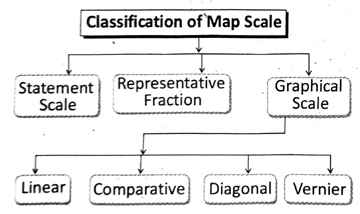
- Statement scale: When the distance between two points on a map and the corresponding distance between these two points on the actual ground is expressed in a descriptive manner, i.e., in statement form, it is called a statement scale. For example, 1 cm = 2 km. This means that 1 cm distance on the map represents 2 km distance on the ground.
- Representative fraction scale: When the map distance and actual ground distance is expressed as a ratio, it is called a representative fraction. E.g., if in a map the scale is mentioned as 1:4000, it implies that 1 unit distance on the map is equivalent to 4000 units distance on the actual ground.
- Graphical scale or drawn scale: When the distance on the map and the corresponding distance on the actual ground is shown with the help of a graphical representation, it is called a graphical scale. Graphical scales can be further divided into four types-
- Linear scale: When the map distance and ground distance is represented by drawing a straight line with measurements on it, it is called a linear scale.
- Comparative scale: When two different units are represented at the same time with different measurements indicated on either side of a straight line, it is called a comparative scale.
- Vernier scale: In this scale, a small scale slides along a main scale, indicating the actual measurement that lies between two marks on the main scale. This scale can measure very small areas.
- Diagonal scale: When the primary divisions of a linear scale are converted into further subdivisions for accurate measurements, the scale used is called a diagonal scale.
2. What are the uses and importance of scale in maps?
Ans. Uses of scale in maps: The different uses of scale in maps are as follows- (1) The actual size of any area on a map can easily be determined with the help of a scale. (2) Use of scale is mandatory for drawing an accurate map. (3) Any map can be reduced or enlarged accurately with the help of scale. (4) The distance between any two points can be measured on a map with the help of scale in order to determine the actual distance on the ground. (5) Land can be measured accurately using vernier scale.
Importance of scale: The importance of scale in maps are as follows- (1) A map cannot be drawn and is incomplete without a scale. (2) Scale is important for determining the length, width, etc., of any region. (3) Scale is valuable in determining the cost of building or contracting anything by a planner or a designer. (4) Vernier scale is important for taking minute measurements.
Short Explanatory Answer Type Questions
1. What are the uses of scale of a map?
Ans. The use of scale of a map are- (1) The area of a land shown in the map can easily be determined with the help of scale. (2) Usage of scale is necessary to draw the map perfectly. (3) A map can be reduced or enlarged with the change of the scale. (4) The actual distance between two places on the ground can be determined by measuring the distance between those two places on the map with the help of scale.
2. What are the importance of scale of a map?
Ans. The importance of scale of a map are- (1) It is not possible to draw a map without a scale. (2) A scale is important to determine the length, width and height of any place. (3) Scale is very important to the planners or designers when they draw designs, because they can cite estimation of their project costs. (4) Vernier scale is important for taking fractional measurements.
3. ‘Scales are of utmost importance in maps.’ Why?
Ans. A scale is important in a map due to the following reasons-
- Measurement: A map can be reduced or enlarged using a scale. Distance between two points, area of a region, can also be calculated using a scale.
- Representation of the Earth: The threedimensional world can easily be represented on a two-dimensional surface (paper) with the help of a scale.
- Other uses: Scales are vital in geographical researches, surveys, defence purposes, etc.
4. What are the advantages and disadvantages of a statement scale?
Ans. A statement scale has various advantages and disadvantages.
Advantages: Some of its advantages are- (1) It is a simple scale, and can be used easily for interpreting maps. (2) As it is written in the form of a statement, there is no need of drawing. (3) Complex mathematical calculations are not required in this scale.
Disadvantages: Some of the disadvantages of a statement scale are- (1) Only the person who knows the language in which the scale is written will be able to comprehend it. (2) Changing the units of measurement is difficult in this system, and is a time consuming process. (3) If the map is enlarged or reduced, the scale has to be calculated again.
5 Mention the advantages and disadvantages of a linear scale.
Ans. A linear scale has its own set of advantages and disadvantages.
Advantages: Some of its advantages are- (1) This scale is very easy to understand as the calculations are not complex. (2) In case of enlargement or reduction of the map, the linear scale gets reduced or enlarged proportionately. Thus, the map distance and the ground distance remain the same. (3) The area of a map can be easily determined with the help of this scale. (4) A short distance on a map can also be measured accurately with the help of this scale.
Disadvantages: Some of its disadvantages are- (1) Calculations required for drawing this scale is very complex. (2) Designing the scale along with headings to make it presentable is a laborious and time consuming process.
Short Answer Type Questions
1. What is meant by a map scale?
Ans. A map scale is the ratio of the distance between two points on a map and their corresponding distance on ground. Example- 1 cm to 500 m.
2. What is a fractional scale?
Ans. The ratio of the distance between two points on a map and the distance between those points on the ground is called fractional scale. For example, 1:3000 indicates that 1 unit on the map is equal to 3000 units on the Earth’s surface.
3. On the basis of representation, how many types of scales are there and what are they?
Ans. There are 3 types of scale- (1) statement scale, (2) representative fraction, (3) graphical scale.
4. What is a statement scale?
Ans. In a statement scale, the scale of a map is written in the form of a sentence. For example, 1 cm to 2 km, where 1 cm on the map is equivalent to 2 km on the ground.
5. Write two advantages of a statement scale.
Ans. Two advantages of a statement scale are as follows- (1) It can be expressed easily. (2) Calculations can be avoided and graphical representation is not necessary as well.
6. What will be the statement scale of a map if the fractional scale is 1:50000?
Ans. The fractional scale of a map is 1:50000. There is no fixed unit of this scale. Therefore, this scale can be converted to a statement scale easily, with the help of any specific unit. In this case numerator of the ratio is 1, that always represents the map distance and denominator is 50000 which denotes the ground distance. This fractional scale can be changed to a statement scale in the following way-distance of 1 cm on the map represents 50000 cm or 500 metres on the ground.
7. Write two advantages of a fractional scale.
Ans. Two advantages of a fractional scale are as follows- (1) This is a unitless scale, hence the scale can be changed easily. (2) This scale can be easily converted to a statement scale or a linear scale.
8. What is a graphical scale?
Ans. When the relation of the map distance between two points and the actual distance between those two is shown with the help of a graphical representation, it is known as a graphical scale.
9. What is a linear scale?
Ans. A linear scale refers to a straight line that is used to measure directly the distance between two points on the map and the actual ground distance between those two points. There are two divisions on this scale primary and secondary.
10. Write two advantages of a linear scale.
Ans. Two advantages of a linear scale are as follows- (1) It is easy to understand since it is depicted as a straight line. (2) If the map is enlarged or reduced, the scale can also be changed accordingly with ease.
11. What is a comparative scale?
Ans. Measurements in two different units can be compared in a comparative scale. In this case, the primary and secondary parts have the same value, but they have different units. For example, 10 km and 10 miles.
12. What is a diagonal scale?
Ans. A scale where two sets of lines cross each other obliquely, forming grids, which provides measurements for smaller units which cannot be obtained generally, is known as a diagonal scale. accurate
13. What is a vernier scale?
Ans. In a vernier scale, a smaller scale is attached to the main scale, which is movable and can be used to obtain small fractional measurements accurately. It indicates the measurement that lies between two marks on the main scale.
14. What is the importance of scale in a map?
Ans. A scale is of vital importance in the drawing of a map. A map is a two-dimensional representation of the world or any part of it, and this representation can be made accurately only with the use of a scale.
15. Write two disadvantages of a fractional scale.
Ans. Two disadvantages of a fractional scale are as follows- (1) It is difficult for amateur readers to comprehend this scale. (2) If a map is reduced or enlarged, the scale has to be made afresh.
16. What are primary and secondary divisions on a linear scale?
Ans. When a straight line of a particular length is divided into a specific number of parts, which are equal in length, each of those divisions is known as a primary division. If these divisions are further divided into smaller parts, those are known secondary divisions.
Multiple Choice Type Questions [MCQ type]
Write the correct answer from the given alternatives
1. The scale that can be used in any country of the world is-
A. linear scale
B. statement scale
C. fractional scale
D. diagonal scale
Ans. C
2. 1 mile is equal to-
A. 63000 inches
B. 63360 inches
C. 63390 inches
D. 63500 inches
Ans. B
3. The R.F. of a map is 1 : 10000. To make the new R.F. of the map 1:5000, it should be enlarged by-
A. 2 times
B. 3 times
C. 4 times
D. 5 times
Ans. C
4. The main advantage of a statement scale is that it is-
A. easy to understand
B. small in size
C. can be shown on a bigger scale
D. none of these
Ans. A
5. Diagonal scale is a type of-
A. graphical scale
B. fractional scale
C. statement scale
D. linear scale
Ans. A
6. The ratio of the distance between two points on a map and the actual ground distance between those two points is called-
A. statement scale
B. graphical scale
C. fractional scale
D. comparative scale
Ans. C
7. The inventor of the vernier scale is-
A. John Vernier
B. Pierre Vernier
C. Lear Vernier
D. None of them
Ans. B
8. 1 mile is equal to-
A. 1.6093 km
B. 0.1623 km
C. 1.9602 km
D. 1.3206 km
Ans. A
9. 1 nautical mile is equal to-
A. 1.582 km
B. 1.852 km
C. 1.285 km
D. 1.962 km
Ans. B
10. 2 cm to 2 km is a-
A. statement scale
B. reflectional scale
C. graphical scale
D. vernier scale
Ans. A
11. Numerator of R.F or fractional scale of map is always-
A. 1
B. 10
C. 100
D. 1000
Ans. A
Very Short Answer Type Questions
Fill in the blanks with suitable words
1. The length of 1 secondary division is …….. than a primary division on a linear scale.
Ans. less
2. The ……… scale is used predominantly in maps.
Ans. linear
3. The relationship of the ratio of the scale of a map with the reduction and enlargement of a map is ……….
Ans. inverse
4. In a ……… scale, a part of a fraction can also be measured accurately.
Ans. vernier
5. The fractional scale is a ………. scale.
Ans. unitless
6. The small divisions of a graphical scale are called ……….
Ans. primary divisions
7. In a cadastral map, the general scale is ……. inches to 1 mile.
Ans. 16
8. There are primary, secondary and ……… divisions in a diagonal scale.
Ans. tertiary
9. To draw a large scale map, ………. scale is used mostly.
Ans. linear
10. The great advantage of R.F. scale is its universal use, because it is a ………. scale.
Ans. proportional
If the statement is true, write ‘T’ and if false, write ‘F’ against the following
1. The statement scale is of no use if a map is enlarged or reduced in size.
Ans. T
2. There is no unit in a fractional scale.
Ans. T
3. The vernier constant is measured in a diagonal scale.
Ans. F
4. The R.F. 1: 50000 in a map means that 1 cm on the map is equal to 500 m on the actual ground surface.
Ans. T
5. 1 inch is equal to 2.54 cm.
Ans. T
6. The primary division of a linear scale always refers to the summation of secondary divisions.
Ans. T
7. The ratio of scale increases when a map is enlarged.
Ans. F
8. The ratio of scale increases when a map is reduced.
Ans. T
Answer in one or two words
1. What is the ratio of the distance between two points on a map and those two points on the ground known as?
Ans. Map scale.
2. Name an instrument where the vernier scale is seen.
Ans. Barometer.
3. What is the other name of diagonal scale?
Ans. Gunter’s scale.
4. Which scale is used to compare two units?
Ans. Comparative scale.
5. What do the figures on the left side of a fractional scale indicate?
Ans. Map distance.
6. What do the figures on the right side of a fractional scale indicate?
Ans. Ground distance.
7. Which scale is represented graphically?
Ans. Graphical scale.
8. How many types of graphical scale are there?
Ans. 4 types.
9. What type of scale is a vernier scale?
Ans. Graphical scale.
10. 1 inch is equal to how many cm?
Ans. 2.54 cm.
11. When a map is reduced in size, how does its scale change?
Ans. It is enlarged.
12. How many types of maps are there, based on scale?
Ans. Three types.
13. 1 km is equal to how many miles?
Ans. 0.6214 mile.
14. What is the other name of fractional scale?
Ans. Representative fraction.
